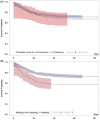Thromboembolic and bleeding events in ICU patients with COVID-19: A nationwide, observational study
- PMID: 36263897
- PMCID: PMC9874434
- DOI: 10.1111/aas.14157
Thromboembolic and bleeding events in ICU patients with COVID-19: A nationwide, observational study
Abstract
Background: Intensive care unit (ICU) patients with Coronavirus disease 2019 (COVID-19) have an increased risk of thromboembolic complications. We describe the occurrence of thromboembolic and bleeding events in all ICU patients with COVID-19 in Denmark during the first and second waves of the pandemic.
Methods: This was a sub-study of the Danish Intensive Care Covid database, in which all patients with SARS-CoV-2 admitted to Danish ICUs from 10th March 2020 to 30th June 2021 were included. We registered coagulation variables at admission, and all thromboembolic and bleeding events, and the use of heparins during ICU stay. Variables associated with thrombosis and bleeding and any association with 90-day mortality were estimated using Cox regression analyses.
Results: We included 1369 patients in this sub-study; 158 (12%, 95% confidence interval 10-13) had a thromboembolic event in ICU and 309 (23%, 20-25) had a bleeding event, among whom 81 patients (6%, 4.8-7.3) had major bleeding. We found that mechanical ventilation and increased D-dimer were associated with thrombosis and mechanical ventilation, low platelet count and presence of haematological malignancy were associated with bleeding. Most patients (76%) received increased doses of thromboprophylaxis during their ICU stay. Thromboembolic events were not associated with mortality in adjusted analysis (hazard ratio 1.35 [0.91-2.01, p = .14], whereas bleeding events were 1.55 [1.18-2.05, p = .002]).
Conclusions: Both thromboembolic and bleeding events frequently occurred in ICU patients with COVID-19. Based on these data, it is not apparent that increased doses of thromboprophylaxis were beneficial.
Keywords: COVID-19; bleeding; thromboprophylaxis; thrombosis.
© 2022 The Authors. Acta Anaesthesiologica Scandinavica published by John Wiley & Sons Ltd on behalf of Acta Anaesthesiologica Scandinavica Foundation.
Figures


References
Publication types
MeSH terms
Substances
LinkOut - more resources
Full Text Sources
Medical
Miscellaneous

